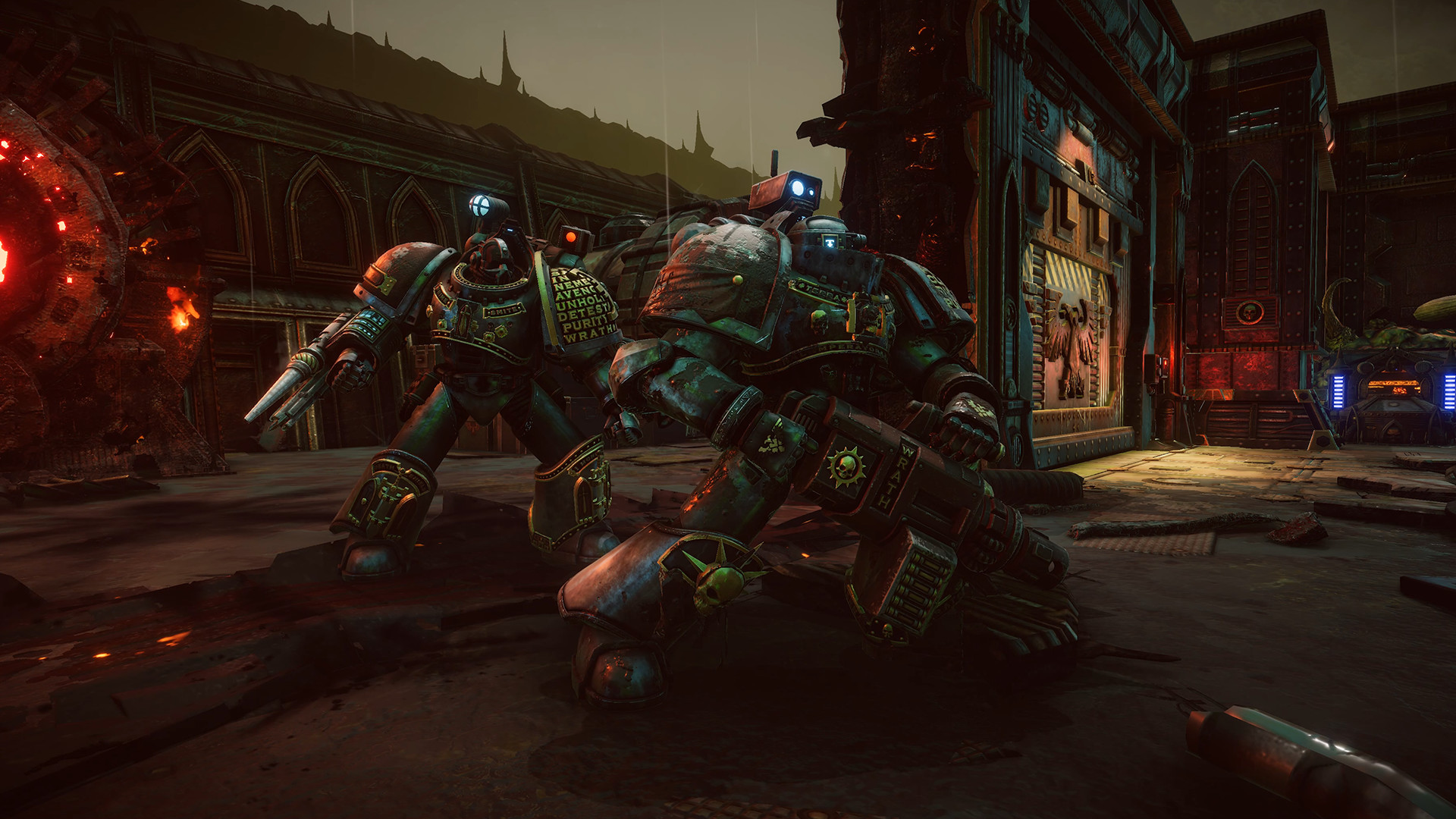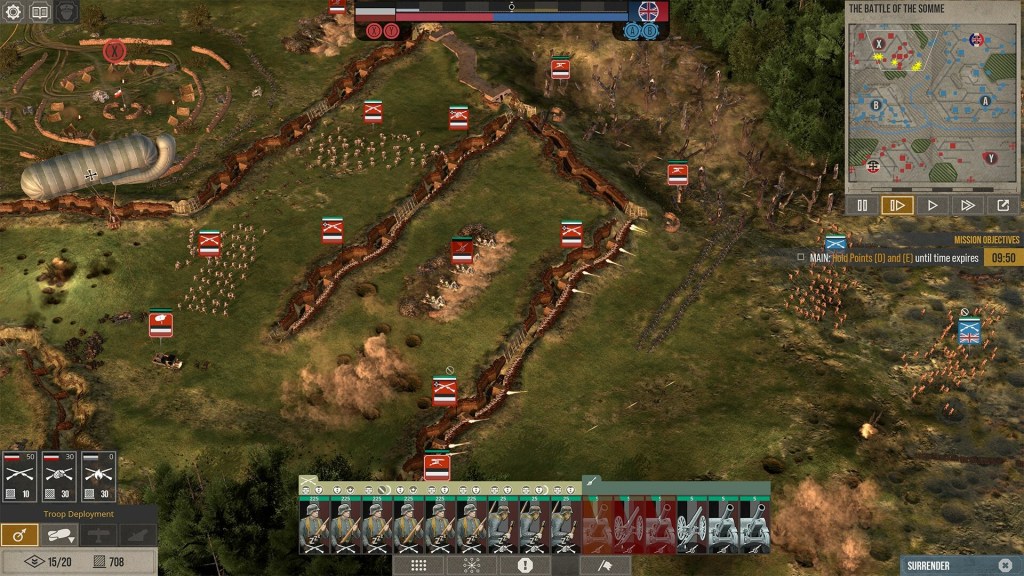What do you do with Space Marines? According to the fiction of Warhammer 40K, they’re functionally immortal superhumans encased in impervious power armor that is so well-crafted they hardly sacrifice any speed or agility. After all, as various games, sourcebooks, and novels all remind us, the “Adeptus Astartes” are the last and most elite line of defense of the ever-decaying Imperium, demi-gods of the setting’s endless battlefields.
Demi-gods do not satisfying game balance make, however. So there’s always a tension between how the Space Marines are described, and the way that they have to be appropriately balanced against their enemies in games. After all, the Space Marine might be the mascot of Games Workshop’s 40K universe, but that doesn’t mean they can be allowed to bully Eldar and Necron players right off the table. Likewise, the lore of 40K might say that a squad of Space Marines can slaughter thousands of Orks but in the RTS games that Relic made, that was mooted to mean that Space Marine squads were slightly smaller and hardier, than their foes, but not qualitatively a breed apart. That’s fine, fantastical themes are hard to bring across in a balanced game system, but at the same time, sometimes I find myself wishing the games of 40K played a bit more like the better stories in that universe.
Videos by VICE
Warhammer 40K: Chaos Gate – Daemonhunters is that game. Among its accomplishments there is none I find more remarkable than the fact that it consistently feels like you are at once massively overmatched and vulnerable and also in command of a squad of unstoppable, fearless ass-kickers.

When I think about some of the absolute best, most white-knuckle battles that Austin and I experienced in a long XCOM 2 campaign, I am thinking about maybe a half dozen missions across something like several dozen. Daemonhunters hits that level of intensity just about every third or fourth time I go on a mission. There have been numerous battles where if things had gone on a single turn longer, I’d have been overwhelmed and slaughtered. But thanks to last-second Space Marine heroics powered by an endless and varied bag of tactical tricks, overwhelming odds are suddenly and violently evened-up.
This dynamic is driven by a nice variety of mission types and special mechanics that generate an even greater variety of twists and complications to each mission. Missions escalate in intensity due to a few factors, but your squads also gain resources from combat making them able to perform feats of heroism to meet the increasing danger. All this is justified in large measure by a cleverly conceived story that walks that always-crucial line between 40K grimdark self-seriousness and tongue-in-cheek pisstaking.
The setup in Daemonhunters is that you have taken over a battered detachment of Grey Knights Space Marines, a special chapter of the Adeptus Astartes who typically lurk in the background of Warhammer 40K stories as the lone unit that is directly assigned to work on behalf of the cruel Inquisition. The Grey Knights are also unique among the Marines because they are allegedly the direct genetic descendants of the Emperor (oops, all Primarchs!) and have extensive magical abilities as a rule rather than the exception. In other words, the perfect Space Marine chapter if you want a skill tree with branches other than “Punching, Shooting, Bible Study”.

As your band of Knights limp homeward after a bad campaign, an Imperial Inquisitor shows up to commandeer their service to help her battle a mysterious new plague that looks like it has the hand of the Chaos God Nurgle behind it. It’s tempting to read Covid-19 into the plague-battling structure of the campaign, and there are moments that some of dialogue alludes to the failed-state dynamics that have allowed the disease to propagate, but the more direct parallel is the board game Pandemic. In between story-advancing missions, you try and tamp down the plague by responding to fresh outbreaks on a map of the local Imperial sector, trying to get boots on the ground before the infection takes permanent root.
The immediate problem you face, besides the Chaos plague and attendant cultists, is the fact that your unit has to launch its new campaign with a broken spaceship, a skeleton crew of Marines, and hardly any equipment. While the resultant progressions systems around this are fairly familiar, I will say that even on the normal difficulty, the trade offs between progression tracks are significant and have a major impact on the course of your campaign. For instance, if you spend Servitors (cyborg slaves who are basically 40K’s vision for the future of unorganized labor) on upgrading your ship’s engines, you can zip from plague outbreak to plague outbreak at a faster clip, tamping down multiple outbreaks before they can spread. But each of those responses necessitates a battle, so while you can be in more places in time to prevent the outbreak from worsening, you weren’t able to spend those same Servitors on upgrading the medical facilities that could get wounded Marines back to action faster, or upgrading the barracks that would allow you to have a deeper roster. So now you can operate at a faster tempo, but you don’t have the bench or the facilities to sustain the cost of doing more missions.
These pressures on time, personnel, or infrastructure can be mitigated but they don’t really go away: you are going to have to absorb some major inconveniences to enjoy major benefits. Though I suppose if you’re such a stone-cold commander that your Marines aren’t getting shot-up, you can risk not having a big barracks or a good hospital.

But to paraphrase the IRA, you have to be brilliant all the time. Chaos only has to be lucky once. Missions can go bad fast and change the entire tenor of a campaign in the blink of an eye, in part thanks to the way those outbreaks interact with the XCOM-like tactical layer. Every time you land on a planet, there is a warp surge gauge that fills up at the end of each turn. If there is no chaos on the planet, the gauge fills slowly, though it will increase faster as you make use of your Marines’ warp-powered psyker abilities. However, if the planet has been left untreated and there are. say, three stacks of Chaos on it, then the meter can fill by a third or more every turn. Once it fills up, it triggers a “Warp Surge” and something bad happens.
What that something is varies a lot depending on the exact threat you face, but in general each time the meter fills up, either your enemies get a huge bonus, you get a huge debuff, or you simply face more enemy reinforcements. I promise you, at first this will not seem like a big deal. But the first time you’re on a mission where the bar is filling up every three or four turns, each time making your forces weaker or causing enemies to get obnoxiously tough and numerous, you’ll realize how every untreated Chaos infestation is a ticking time bomb.
Yet the game has yet to feel broken or annoying despite these escalation mechanics and the way the game often swarms you with enemies and hindrances, and I tend to have a low tolerance for this kind of thing. The way Darkest Dungeon could trigger failure cascades to wash hours of progress down the drain in just a few minutes ended up putting me off the game, even though I broadly loved most of what it was doing. I’m fairly quick to reload in XCOM 2 if it feels like a victory is about to be Pyrrhic. Daemonhunters goes right up to the line of invoking that kind of frustration or defeatism… but it stops short. And slowly but surely, in mission after mission, it turns out there’s a way to claw your way to victory.

Not without cost, however. Your Marines generally have heavy armor that shrugs off light attacks completely and yields actual hit-point stingily. They’re incredibly hard to bring down, and in fact you’ll quickly learn that sometimes the best and smartest move is to abandon cover and just stand in the open trading point-blank shots and body blows because that’s what your Marines are made for. With the aid of their psychic powers and combo abilities, they can often run gauntlets of enemies and break their entire position down from a sudden flank, all without taking any disabling hits.
The catch is that while they’re hard to kill, they’re easily bruised in all this combat. The more hit points a Grey Knight loses on a mission, the longer he is recuperating. If he’s brought down during a mission and revived (they get auto-revived after three turns), then he’s got to recover from a “critical wound” before they’re on normal injured reserve, where they can start missions on reduced hit points if you really need to get them into the field. There’s a tight connection between how cleanly you’re winning, how much experience you can pile onto your top soldiers, and how many troops you have ready for combat at any one moment.
The whole dynamic has great shades of BattleTech where your units were, on the one hand, incredible durable, but on the other hand, getting them back from the brink of death to full health required a huge investment of time, a resource that is increasingly scarce as the game rolls along.

I’m only a little ways into the second act of the game, where things are really opening-up while the danger is escalating and taking on new forms. I do wonder if this tightrope act Daemonhunters is performing in the Goldilocks zone between forgiveness and punishment for imperfect play can be sustained the length of an entire campaign, but frankly I didn’t think it would even get this far without breaking to one extreme or the other. Even if it stumbles down the stretch, it won’t diminish the fact this is an arresting tactics game and an essential 40K game.
More
From VICE
-

Screenshot: SEGA -

Screenshot: Another Axiom Inc. -

-

